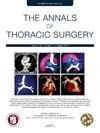胸腔肿瘤外科区域化的长期影响。
IF 3.6
2区 医学
Q1 CARDIAC & CARDIOVASCULAR SYSTEMS
引用次数: 0
摘要
背景:2007 年,安大略省癌症护理中心制定了胸外科肿瘤标准,用于提供包括肺叶切除术、食管切除术和肺切除术在内的手术。这些标准将胸外科手术划分到指定的中心,并规定了物质和人力资源。本分析旨在确定这些标准(以下简称 "区域化")对加拿大安大略省胸部肿瘤手术后疗效的影响:对接受肺叶切除术、食管切除术或肺切除术的患者进行人群分析,使用多层次回归模型比较区域化之前、期间和之后的 30 天和 90 天死亡率以及住院时间。使用间断时间序列模型评估区域化的影响,同时控制持续趋势:研究期间共进行了 22,195 例手术(14,902 例肺叶切除术、4,958 例食管切除术和 2,408 例肺部切除术)。>区域化后,超过 99% 的病例在指定中心进行。区域化后,每个指定中心的肺叶切除术和食管切除术的年平均手术量增加,而肺切除术的年平均手术量减少。在研究期间,肺叶切除术和食管切除术的 30 天和 90 天死亡率及住院时间均有所改善,而肺切除术的 90 天死亡率也有所改善。然而,间断时间序列分析并未显示出区域化对这些结果有任何统计学意义上的显著影响,这与之前存在的趋势无关:结论:2003 年至 2020 年期间,各省胸部肿瘤外科的死亡率和住院时间均有持续改善,但本分析并未将这些改善归因于包括区域化在内的胸部肿瘤外科标准的实施。本文章由计算机程序翻译,如有差异,请以英文原文为准。
Long-Term Impact of Regionalization of Thoracic Oncology Surgery
Background
In 2007, Cancer Care Ontario created Thoracic Surgical Oncology Standards for the delivery of surgery, including lobectomy, esophagectomy, and pneumonectomy. These standards regionalized thoracic surgery into designated centers and mandated physical and human resources. This analysis sought to identify the impact of these standards, hereafter referred to as “regionalization,” on outcomes after thoracic oncology surgery in Ontario, Canada.
Methods
This study was a population-level analysis of patients undergoing lobectomy, esophagectomy, or pneumonectomy, and it used multilevel regression models to compare 30- and 90-day mortality and length of stay before, during, and after regionalization. Interrupted time series models were used to assess for an impact of regionalization while controlling for ongoing trends.
Results
A total of 22,195 surgical procedures (14,902 lobectomies, 4958 esophagectomies, and 2408 pneumonectomies) were performed within the study period. A total of >99% of cases were performed at a designated center after regionalization. Mean annual volumes per designated center increased after regionalization for lobectomy and esophagectomy and decreased for pneumonectomy. The 30- and 90-day mortality and length of stay improved for lobectomy and esophagectomy over the study period, as did 90-day mortality for pneumonectomy. However, the interrupted time series analysis did not demonstrate any statistically significant effect of regionalization on these outcomes, separate from preexisting trends.
Conclusions
Consistent improvements in mortality and length of stay in thoracic surgical oncology occurred on a provincial level between 2003 and 2020, although this analysis does not attribute these improvements to implementation of Thoracic Surgical Oncology Standards including regionalization.
求助全文
通过发布文献求助,成功后即可免费获取论文全文。
去求助
来源期刊

Annals of Thoracic Surgery
医学-呼吸系统
CiteScore
6.40
自引率
13.00%
发文量
1235
审稿时长
42 days
期刊介绍:
The mission of The Annals of Thoracic Surgery is to promote scholarship in cardiothoracic surgery patient care, clinical practice, research, education, and policy. As the official journal of two of the largest American associations in its specialty, this leading monthly enjoys outstanding editorial leadership and maintains rigorous selection standards.
The Annals of Thoracic Surgery features:
• Full-length original articles on clinical advances, current surgical methods, and controversial topics and techniques
• New Technology articles
• Case reports
• "How-to-do-it" features
• Reviews of current literature
• Supplements on symposia
• Commentary pieces and correspondence
• CME
• Online-only case reports, "how-to-do-its", and images in cardiothoracic surgery.
An authoritative, clinically oriented, comprehensive resource, The Annals of Thoracic Surgery is committed to providing a place for all thoracic surgeons to relate experiences which will help improve patient care.
 求助内容:
求助内容: 应助结果提醒方式:
应助结果提醒方式:


